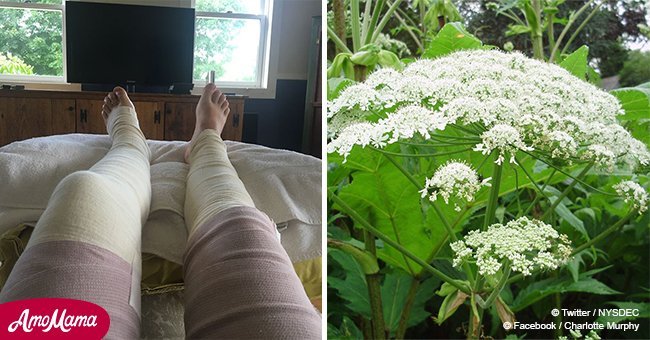
Woman suffers severe burns after coming into contact with common plant
Charlotte Murphy took to Facebook to post a detailed account of her experience with wild parsnip, which gave her severe blisters and burns all over her legs.
Murphy, whose post had gone viral, hoped that by sharing her story, she could spread awareness and help others to avoid such circumstance.
Her post came more than a week after she came into contact with the common plant along a Vermont road, where she stopped to go to the bathroom.
She was not aware at the time that her leg had brushed against one of the plant’s broken leaves. Murphy explained she just went about her day under the hot sun afterward.
Follow us on Twitter at AmoMama USA for more details about the effects of wild parsnip on human skin.
Murphy said the sun had triggered the plant’s sap to cause such serious effects on her skin.
On her post, she wrote, ‘A few bumps appeared within a couple days but no pain or itch. I continued working out in the sun allowing more sweat and UV rays to hit the skin, making the reaction that came a week later much worse than if I had washed my skin right away and stayed out of the sun.’
Over the next couple of days, Murphy’s leg became itchier and very red. One day, she woke up with huge, yellow blisters on her leg.
Murphy said that it reached a point where she was not able to walk because of her swollen leg. Eventually, the blisters reached her other leg, her arms, and fingers.
Wild parsnips or Pastinaca sativa L. produce a sap that reacts when exposed to sunlight. Eike Blohm, MD, an emergency physician and medical toxicologist at the University of Vermont, explained to Health.com that the sap forms a certain compound that is toxic to skin cells.
As he further clarified, touching the plant does no harm to humans, but if the stem or leaves are broken and the sap is exposed, it can have damaging effects on the affected areas of the skin.
Dr. Blohm said the occurrence is called phytophotodermatitis and it is the plant’s natural defense of various types of plant-eating fungus.
When the sap comes into contact with the skin and is exposed to the sun, there is a chemical reaction and it damages DNA, which makes skin cells die and causes blisters and scarring.
Dr. Blohm advised that people exposed to the sap should wash their skin well with soap and water as quickly as possible. Also, he said they should stay out of the sun for at least two complete days.
As for Murphy, she revealed that she is on her way to making a full recovery. ‘The progress is slow but the blisters and swelling have gone down,’ she wrote.
For images of Murphy’s condition, check out her Facebook post. Although, readers should be warned that the images are extremely graphic.